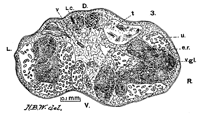Parasitology, Harold W. Manter Laboratory of

Studies from the University of Nebraska Zoological Laboratory
Date of this Version
8-1-1894
Citation
Published in Extract, Proceedings of the Nebraska Academy of Sciences (1894) IV: 8-11.
Abstract
A pond or small lake furnishes few variations in depth, temperature, current, or food, and hence the life in it is comparatively uniform. Nowhere else in the world is there found such a continuous body of fresh water as in the Great Lakes. They afford, in themselves alone, an area of water one-fourth greater than that of the state of Nebraska; or, considering the streams and minor lakes within easy reach, no doubt the area is twice as great. Furthermore, there are found here conditions of temperature, depth, light and food more nearly like those prevailing in the ocean. As a result the development of life is greater than in fresh water elsewhere. The existence of a peculiar deep-water fauna has been known for some time, but its extent and the general biological condition of the lakes have never been the object of extended observations. The state of Michigan is bordered by all of the chain except Lake Ontario, and its fisheries are of a magnitude to warrant the large yearly outlay for fish culture under the auspices of the State Fish Commission, by which are planted every year, 100,000,000 fry of the white fish alone. The importance of full and accurate information concerning the entire biological conditions of the lakes has long been felt; and after some tentative work in previous years, the Commission fitted out last summer a temporary laboratory on Lake Saint Clair. Professor J. E. Reighard, the scientific expert of the commission, was appointed director and under his charge work was carried on for nearly three months. To each of the party under his super-, vision was assigned a particular group; the work on the worms was done by the writer.

